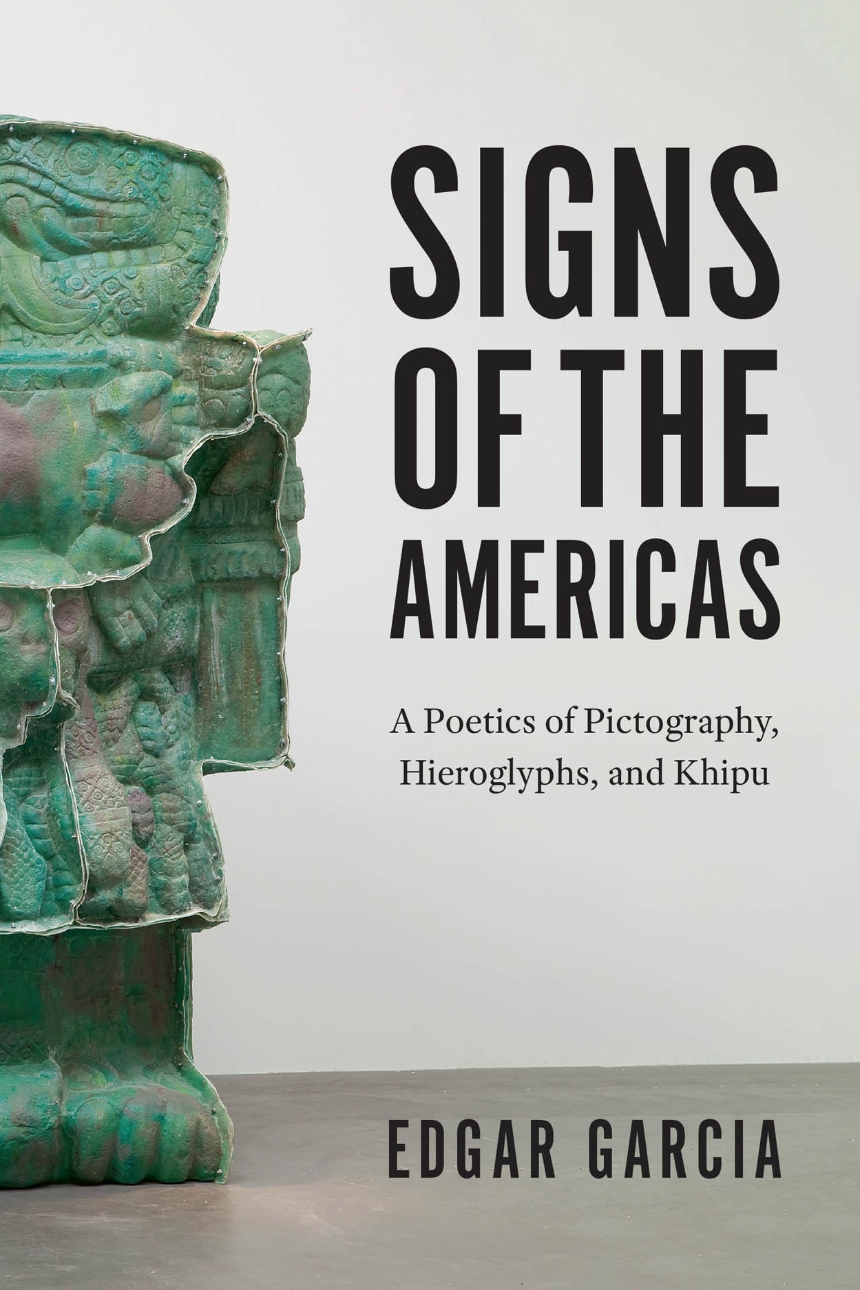Signs of the Americas
A Poetics of Pictography, Hieroglyphs, and Khipu
9780226659022
9780226658971
9780226659169
Signs of the Americas
A Poetics of Pictography, Hieroglyphs, and Khipu
Indigenous sign-systems, such as pictographs, petroglyphs, hieroglyphs, and khipu, are usually understood as relics from an inaccessible past. That is far from the truth, however, as Edgar Garcia makes clear in Signs of the Americas. Rather than being dead languages, these sign-systems have always been living, evolving signifiers, responsive to their circumstances and able to continuously redefine themselves and the nature of the world.
Garcia tells the story of the present life of these sign-systems, examining the contemporary impact they have had on poetry, prose, visual art, legal philosophy, political activism, and environmental thinking. In doing so, he brings together a wide range of indigenous and non-indigenous authors and artists of the Americas, from Aztec priests and Amazonian shamans to Simon Ortiz, Gerald Vizenor, Jaime de Angulo, Charles Olson, Cy Twombly, Gloria Anzaldúa, William Burroughs, Louise Erdrich, Cecilia Vicuña, and many others. From these sources, Garcia depicts the culture of a modern, interconnected hemisphere, revealing that while these “signs of the Americas” have suffered expropriation, misuse, and mistranslation, they have also created their own systems of knowing and being. These indigenous systems help us to rethink categories of race, gender, nationalism, and history. Producing a new way of thinking about our interconnected hemisphere, this ambitious, energizing book redefines what constitutes a “world” in world literature.
Garcia tells the story of the present life of these sign-systems, examining the contemporary impact they have had on poetry, prose, visual art, legal philosophy, political activism, and environmental thinking. In doing so, he brings together a wide range of indigenous and non-indigenous authors and artists of the Americas, from Aztec priests and Amazonian shamans to Simon Ortiz, Gerald Vizenor, Jaime de Angulo, Charles Olson, Cy Twombly, Gloria Anzaldúa, William Burroughs, Louise Erdrich, Cecilia Vicuña, and many others. From these sources, Garcia depicts the culture of a modern, interconnected hemisphere, revealing that while these “signs of the Americas” have suffered expropriation, misuse, and mistranslation, they have also created their own systems of knowing and being. These indigenous systems help us to rethink categories of race, gender, nationalism, and history. Producing a new way of thinking about our interconnected hemisphere, this ambitious, energizing book redefines what constitutes a “world” in world literature.
288 pages | 11 color plates, 31 halftones | 6 x 9 | © 2020
Anthropology: Cultural and Social Anthropology
Literature and Literary Criticism: American and Canadian Literature, General Criticism and Critical Theory
Reviews
Table of Contents
List of Illustrations
Preface: Threshold Magic
Acknowledgments
Introduction: Unnatural Signs
Chapter 1: World Poetry and Its Disavowals: A Poetics of Subsumption from the Aztec Priests to Ed Dorn
Part I: Pictographic Metonyms
Chapter 2: Pictographic Kinships: Simon Ortiz’s Spiral Lands and Jaime de Angulo’s Old Time Stories
Chapter 3: Pictography, Law, and Earth: Gerald Vizenor, John Borrows, and Louise Erdrich
Part II: Metalepsis and Hieroglyphs
Chapter 4: Hieroglyphic Parallelism: Mayan Metalepsis in Charles Olson’s Mayan Letters, Cy Twombly’s Poems to the Sea, and Alurista’s Spik in Glyph?
Part III: Khipu and Other Analeptic Signs
Chapter 5: Death Spaces: Shamanic Signifiers in Gloria Anzaldúa and William Burroughs
Chapter 6: Khipu, Analepsis, and Other Natural Signs: Cecilia Vicuña’s Poetics of Weaving and Joaquín Torres-García’s La Ciudad sin Nombre
Afterword: Anthropological Poetics
Notes
References
Index
Preface: Threshold Magic
Acknowledgments
Introduction: Unnatural Signs
Chapter 1: World Poetry and Its Disavowals: A Poetics of Subsumption from the Aztec Priests to Ed Dorn
Part I: Pictographic Metonyms
Chapter 2: Pictographic Kinships: Simon Ortiz’s Spiral Lands and Jaime de Angulo’s Old Time Stories
Chapter 3: Pictography, Law, and Earth: Gerald Vizenor, John Borrows, and Louise Erdrich
Part II: Metalepsis and Hieroglyphs
Chapter 4: Hieroglyphic Parallelism: Mayan Metalepsis in Charles Olson’s Mayan Letters, Cy Twombly’s Poems to the Sea, and Alurista’s Spik in Glyph?
Part III: Khipu and Other Analeptic Signs
Chapter 5: Death Spaces: Shamanic Signifiers in Gloria Anzaldúa and William Burroughs
Chapter 6: Khipu, Analepsis, and Other Natural Signs: Cecilia Vicuña’s Poetics of Weaving and Joaquín Torres-García’s La Ciudad sin Nombre
Afterword: Anthropological Poetics
Notes
References
Index
Awards
Modernist Studies Association: Modernist Studies Association--First Book Prize
Shortlist
